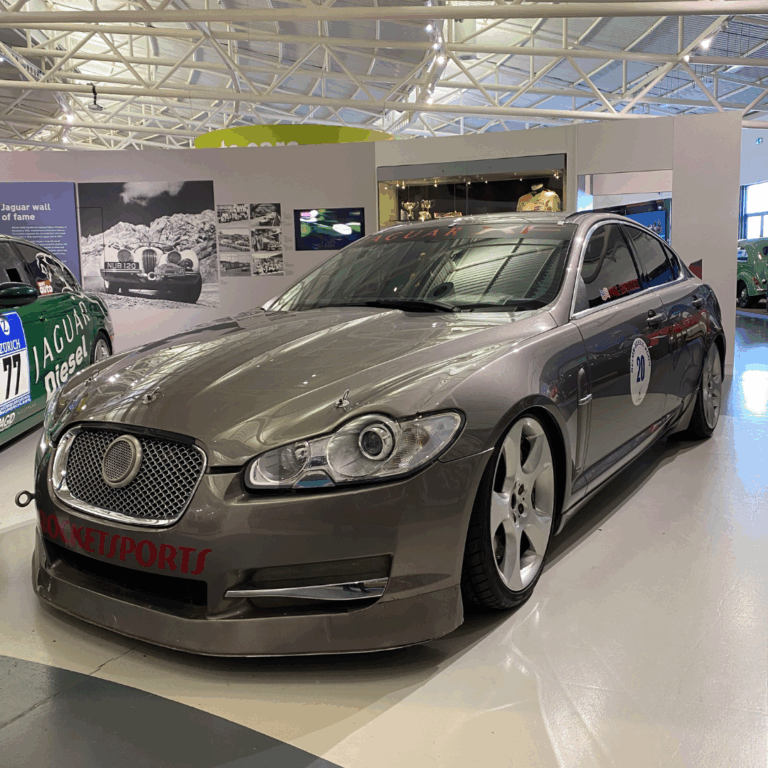
2008 Rocketsports XFR V8
Fastest Jaguar – reached over 225 mph at Bonneville Salt Flats
This Jaguar XFR prototype is the fastest Jaguar ever made (as of 2008), an XFR fitted with the supercharged 5.0 litre engine.
In November 2008, it was driven by Paul Gentilozzi of the US racing team Rocketsports at the Bonneville salt flats in Utah, and was timed at 225.675 mph (363.2 km/h), beating the previous record set in the early 1990s by an XJ220 super car, which reached around 217 mph (349 km/h). To get it to reach that speed, Jaguar engineers gave the XF a remapped ECU, a modified air intake and exhaust, and a revised supercharger. The car was also fitted with a parachute to assist with slowing down from such high speeds. The engine internals were unchanged from the production car and it retained the standard six-speed automatic.
The XF saloon had made its debut at the Frankfurt Motor Show in September 2007, and was warmly welcomed as the first example of Jaguar’s new design direction on a saloon car. Despite the XF being radical steps forward from its S-Type predecessor, Design Chief Ian Callum was very conscious of Jaguar’s heritage. The objective with XF was to create a car which, in the modern age, had an equally great impact as the Jaguars of the past had in their day.
As a result, the XF still had several clear Jaguar design cues. The recessed radiator grille was inspired by the 1968 XJ6. The grille in turn defined the rest of the shape, which was more like the XK fastback coupé than a traditional saloon. The headlamp fairings and the rear side window shape also nodded to tradition. The Jaguar leaper was still found but only on the rear! The interior featured wood and leather, but used in a contemporary and innovative manner.
The new car was built on a developed S-Type platform and used the same engines at launch, ranging from the acclaimed Diesel V6 to the range-topping supercharged 4.2 litre petrol V8. For the 2010 model year, the 4.2 litre V8 was superseded by the new 5.0 litre Gen lll version of the AJ-V8 engine. In supercharged form, this engine produced an incredible 510PS and made its debut in a new XFR model which replaced the prior SV8.
The full story of the development of the Rocketsports XFR was documented in Chapter 13 of David Moore’s book ‘One Moore for the Road’, published in 2020.
David Moore was an engineer who joined Jaguar Cars in August 1990, working at the Whitley Development Centre.
This book relates his thirty year journey through Jaguar Cars, his time in Vehicle Proving, Development and Testing and his close relationship with the PR side of the Company.
He spent much time in vehicle testing both at Jaguar’s own sites at Gaydon and later Fen End, but also at MIRA, Millbrook Proving Ground and various UK race circuits. After some mentoring he was recommended as a member of the High Performance Club. He has driven Jaguars in the Mille Miglia in Italy, Reims circuit in France, the Nevada desert, across ice lakes in Sweden and chauffeured Alex Ferguson.
His last few years at Jaguar were at JLR Classic Works on the edge of Coventry where the Company restores early E-types and has produced Continuation versions of C-type, D-type, XKSS and Lightweight E-type Jaguars.
One Moore for the Road
Author: David Moore
ISBN: 9798618626040
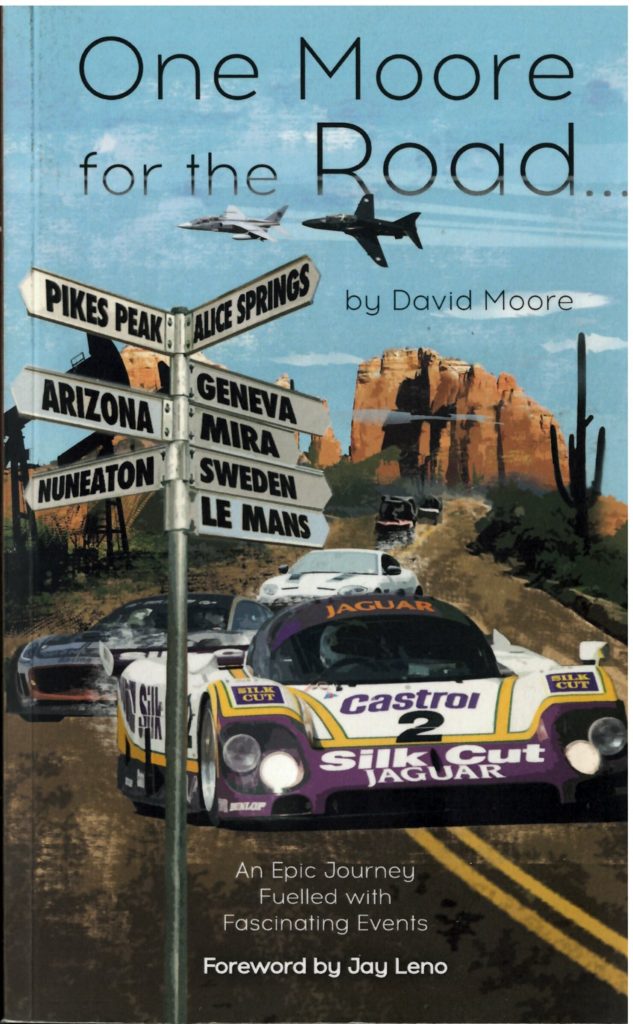
Chapter 13 – The Need For Speed In Bonneville
For as long as I can remember I have always had a fascination with speed and the desire to be fast.
Even when I had a wooden go-kart I was always trying to make it faster by pushing harder or making it lighter or more aerodynamic. I had my first small motorbike when I was quite small but no sooner had I started to ride it and I wanted something bigger and faster. I’m not really sure where I get this desire from because my dad was a polar opposite. Our drives to Great Yarmouth every year were taken at precisely the speed limit and it took us hours. As cars went past us doing just 10 or 15 mph quicker he would lambast them for being hooligans and I just sat in the back wishing I was in the other cars. My Uncle Ray on the other hand was a speed freak and I think that must have rubbed off on me a bit because he actually built me my go-kart, built my first motorbike, took me bike racing and then introduced me to flying so I have to dedicate this chapter to you!
Throughout the XF project we had built up a great relationship with the PR team and they really liked the way the vehicle office did business. We worked very hard but we had so much fun doing it. It was during one of our PR discussions that they asked us for ideas on what we could so with the new car to create some media attention that was a little bit different. There were quite a few ideas that were worth a shout but I had just one thing on my mind and that was to set a top speed at Bonneville. During testing I had a few runs with the unlocked calibrations and the car was extremely fast and my engine build team lead by Dave Warner and Simon Stacey were convinced it could do a lot more. With the data in my back pocket I suggested the idea to the team and they loved it and off the back of this we could launch the car at the LA Motor Show.
With the thumbs up from my Engineering Senior Manager Andy Whyman I did what I have always done and threw myself into the project like a man possessed. The first thing on the agenda was to secure a suitable vehicle from the engineering test fleet. Not too difficult a task seeing as we owned the fleet. With the donor selected the next job was to convince the prototype operations team that they needed to build it. I went over to see my old mate Adi Smith and as soon as I mentioned Bonneville he was in, hook line and sinker. Within a few hours we had a build plan and a designated area in the workshop to build it. That’s the great thing about the guys at Jaguar, they were always passionate about the company and when you were doing something to promote it they were so supportive. Unfortunately this passion has dwindled over the years and I think it’s because people are just more focused on their own ambitions, goals and objectives. The management at the top when I was doing all of this crazy stuff were born and bred Jaguar. They were 2nd and 3rd generation employees who quite literally lived for the brand.
Luckily the powertrain team still had that passion and were fully on board to build us the best engine possible using the AJ133 V8 as the base engine. Dave and Simon had a few ideas with the supercharger and were confident of building us a great engine for the task at hand.
With the wheels in motion I then set up some discussions with our PR team to work out how we were going to do the actual speed runs. I was hoping to get the nod from Ken McConomy to fly out and do the runs myself but Jaguar had connections with a team already out in the USA racing the XK8 called Rocketsports Racing who were more than keen to help out. As the project leader I was given the task to contact the team and come up with a joint plan of attack that would see us build the car and test it then fly it out to the USA for Rocketsports to finish off and prep it for the salt flats.
The head of RSR was a chap called Paul Gentilozzi who made his name in Trans Am racing and had a lot of success with Jaguar in the past. His current team were running the normally aspirated XK8’s over in the USA against Corvette and Porsche. I set up a number of dial in meetings with Paul and his team to discuss the build of the car and making sure the basics would conform to the race specs required for Bonneville. We got as much weight out of the car first getting rid of anything that we didn’t really need so just about all of the trim apart from the seats were ripped out and binned. We replaced the standard seats with bucket race seats and then set about designing a roll cage for the car.
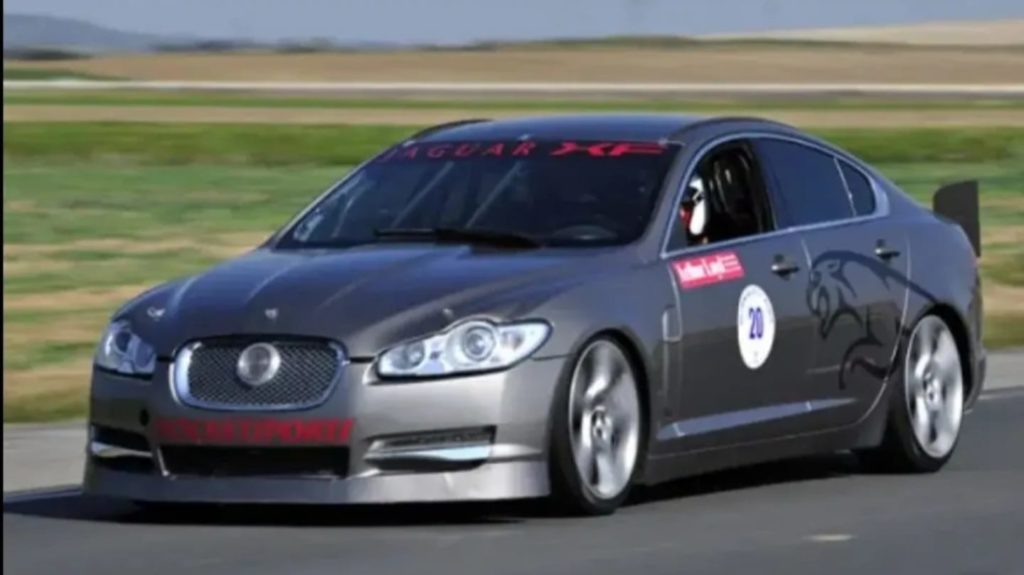
Adi was loving the build and although we were trying to keep it secret word got out at Whitley and we had a few keen visitors taking a peep at what we were doing. The interest is great though and anybody who took the time to come down was always given time to take a look at the build.
Progress was going well but the main part of the car was just about ready. Dave and Simon had taken a stock engine and transformed it with a lot of experience, shed loads of black magic and just a hint of pixie dust into a 600 hp monster. It was dropped into the car and connected up with a lot of excitement from all of the team and it wasn’t long before we could crank it up and make sure it all worked. With a straight through exhaust system it was guaranteed to make a noise but we didn’t expect the thunder it delivered.
We managed to get the whole team around the car for its first start and she didn’t let us down. On pressing the start button to get power, all the gauges did their start up sweep that always looked cool and we were ready for ignition. On the second press her heart burst into life and the super unleaded fuel flowed through her veins while the supercharger scavenged for air like a new born child’s first breath. The roar from the exhaust made the hair on your neck stand up and the crowded workshop loved it as we revved it up some more.
Our dial in with Paul and RSR that evening was a little more exciting now that our baby was alive and we even played a sound clip over the phone to prove the point but our excitement was short lived as Paul advised us that due to it being the end of season at Bonneville and with the weather changing our window of opportunity was getting smaller and we really needed to get the car out asap for it to be prepared in Michigan and then trucked down to the salt flats. My team were fully on board and worked all the hours we could with some sleepless nights thrown in for good measure but the clock really was ticking.
With her flight booked there was no turning back and we just had to deliver. I got a call from Paul to say that the one thing that concerned him was that the new and unlocked engine calibrations really worked because once over in the USA all they could do was add the aero package and some more race magic before the car had to be shipped. What he confirmed was that under no circumstance could the car go on the plane without confirmation that it would go over 185 mph which put the pressure on us a bit with less than 24 hours to go.
The next morning I got together with the build team to confirm that she was checked and ready to go but the weather was not looking good. I called Millbrook which was my first choice and they sadly informed me that it was raining and I got the same response from Bruntingthorpe so it wasn’t looking great but all was not lost.
At times like this you have to go the extra mile and I was presented with an opportunity that allowed me to drive the XFR in excess of 185 mph confirming the calibration changes were working and to all those involved that made it work I thank you for that ultra-top secret test session. As I hit nearly 190 mph I had the biggest grin ever!
Our baby made the flight and arrived in Michigan on time and the RSR boys set about making some significant updates to improve the aerodynamics and get us a better top speed. All the gaps in the bodywork were sealed as was the main radiator grille, rails were added to the roof to make sure all the air went back towards its new and very large rear wing. An all-aluminium underfloor was added to make the air flow really smooth and a set of smaller cross section tyres were fitted to also improve its resistance to air flow.
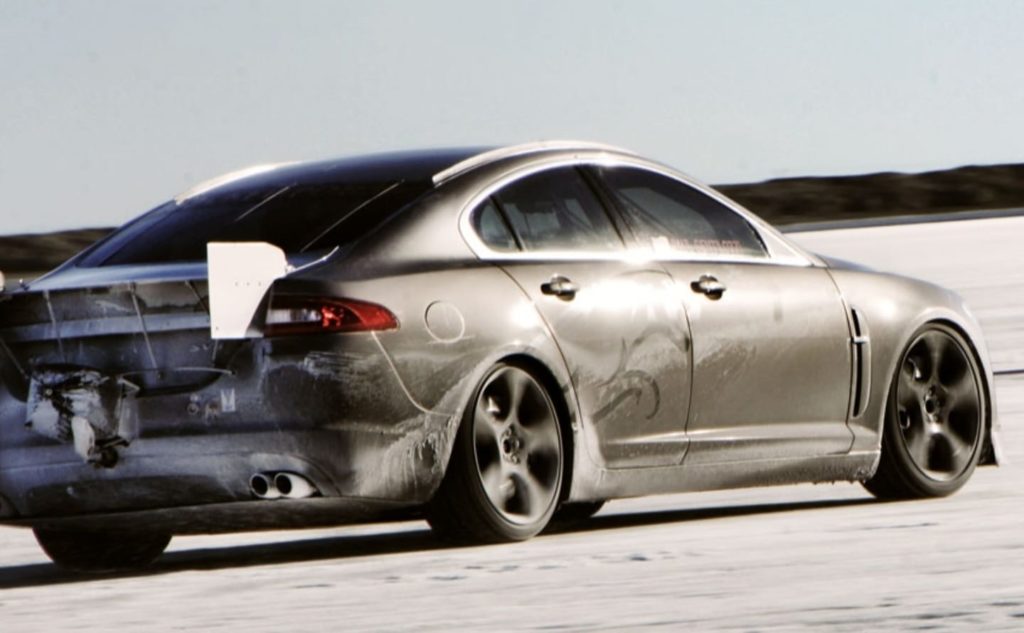
Some extra magic was added to the front grille with some air intake pipes creating a ram air effect and then the piece de la resistance was some nitrous oxide to feed into the intercoolers to ensure they worked at their max by keeping them very cold. In the event that we reached a significant top speed and required some assistance with stopping her in a short distance a parachute system was fitted at the back for good measure.
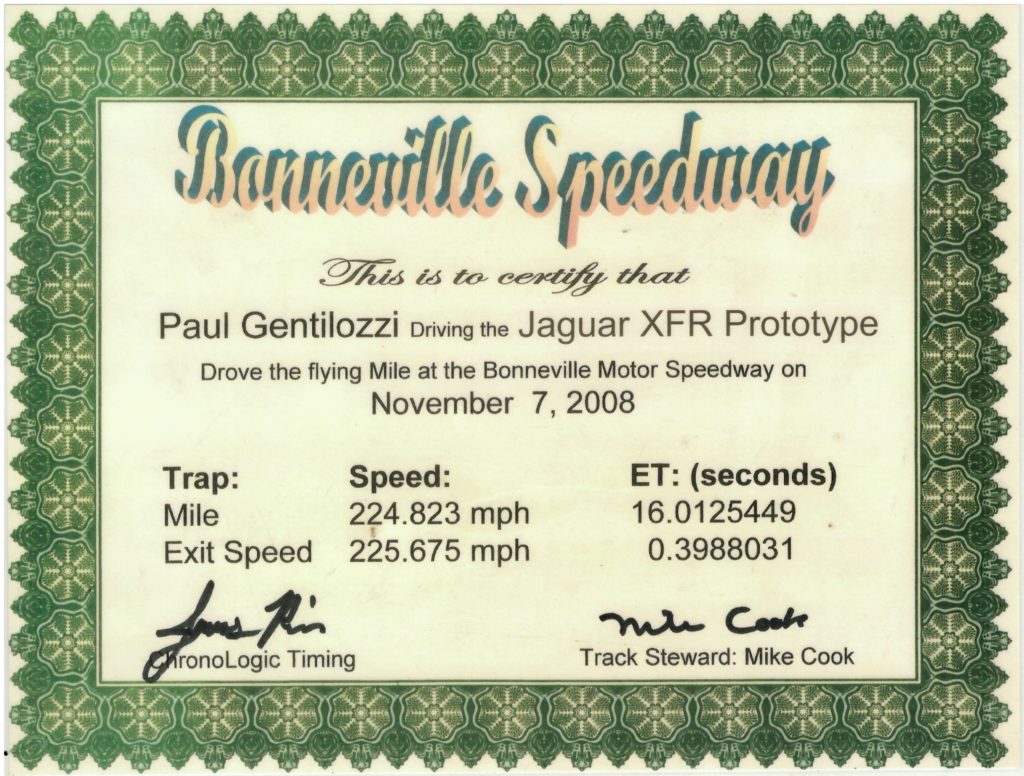
So, on November the 7th 2008 our pride and joy took to the salt flats with Paul Gentilozzi at the wheel. The first runs began and the car suffered trying to keep traction at high speeds as we were using Michelin Pilot Sport tyres inflated to 50 psi to improve rigidity and reduce drag. The problem was resolved when Paul suggested adding ballast to the boot with an extra 250 lbs (118 kg) to make it sit down a bit. Finally the team set off to see what she could do and with the rev counter showing 6,250 rpm our XFR had peaked at 225.675 mph even though we were still amazingly suffering from wheel slip on the salt.
As the times and speed came through we were both ecstatic and emotional. It was a hell of an achievement by a small and dedicated team of Jaguar petrol heads going that extra mile. What we had just done was break Jaguar’s long standing speed record held by Martin Brundle in the XJ220 at Nardo in 1992 when he reached a timed lap at 217.1 mph.
It really was epic and after the event we realised it was even more impressive because the salt flats are at an altitude of 4,200 ft and the salt surface generated a higher drag factor than what you would encounter on tarmac so in reality our 225.675 was probably nearer to 250 mph if we had been on tarmac at sea level.
What an achievement! We had produced the fastest ever Jaguar, and I need to point out at this stage that it was the fastest ever Jaguar on four wheels as my friends in the RAF would soon be chirping up a bit if I didn’t.
The PR team were thrilled and the Media wheels were rolling. The car made its way to LA for the show and the rest as they say is history.
Our baby returned to the UK and I drove her at the Reims race track before she was retired to the Jaguar Daimler Heritage Centre at Gaydon where you can still see today.
Well done to all the team for a great achievement. Adi and Mick from Proto Build, Dave & Simon for the engine, Ian Parsons and Gary Embleton for the calibration support, Roger Wardle for breaking all the rules with the ZF transmission, Kev Gaskins for a funky cooling system, Dan Banks for being an Electrical Wizard (they would have burnt you at the stake in the old days), Andy Whyman and the XF ‘A’ Team for being Vehicle Engineering Legends and finally to Paul and the RSR team for putting the cherry on top of a very fast cake.
All of the above have become my best mates and we all still talk about this with so much pride and passion and I’m sure Sir William Lyons would have approved but the special thanks go to my Uncle Ray who inspired me to go fast or go home.
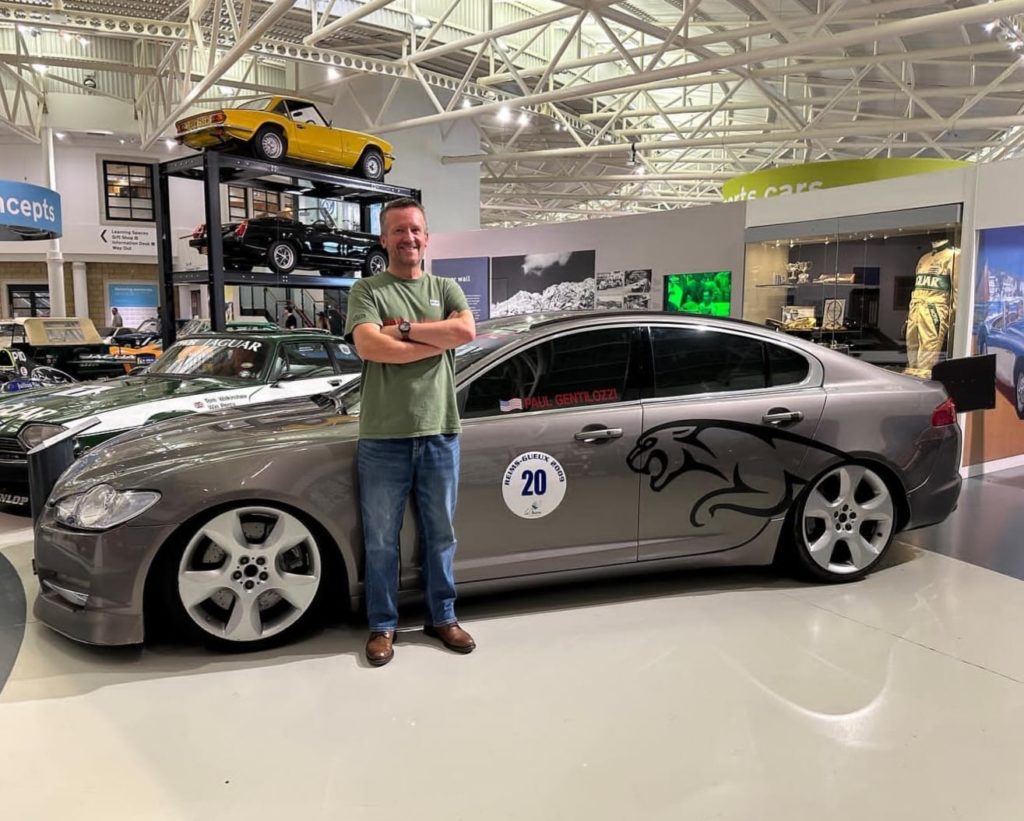
Jaguar Cars issued an official video of the Bonneville Speed record attempt, which is now on the Jaguar Cars Channel on YouTube:
Chassis Number: SAJAC07R991X01841
Owner: The Jaguar Daimler Heritage Trust
Inventory Number: 181/J.120